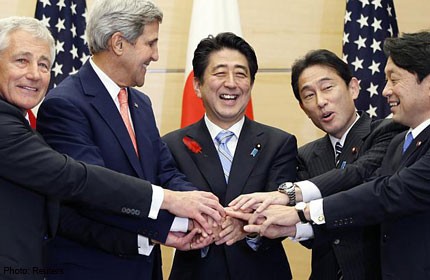Japan, US to update security pact guidelines

Japan and the United States have agreed to update 16-year-old guidelines governing their security alliance so as to address growing concerns over North Korea's nuclear development, global terrorism, cyber warfare and other 21st century threats.
The accord came in so-called "two-by-two" consultations held here on Thursday between Japan's Foreign Minister Fumio Kishida and Defence Minister Itsunori Onodera and their US counterparts John Kerry and Chuck Hagel.
The guidelines, to be ready by end next year, will determine the roles of the Japanese Self-Defence Force and the US military in the alliance for the next 15 to 20 years.
The talks took place amid reports that Pyongyang may have restarted a reactor capable of producing enough plutonium to make one nuclear bomb a year.
A US research team in Washington said satellite imagery showing the release of hot water indicated that the reactor was in operation.
The International Atomic Energy Agency urged North Korea last month to halt nuclear activities, including restarting the reactor.
In separate talks with Mr Onodera earlier on Thursday, Mr Hagel called North Korea's missile programme an "unmistakable threat" to not only Japan, but also South Korea and the US, and said it was important that the three countries cooperate to deal with it.
The defence secretary said after the consultations that "our goal is a more balanced and effective alliance".
In their 10-page joint statement, both sides confirmed the location of a second X-band US missile defence radar system at Kyogamisaki airbase in western Kyoto prefecture to be installed within the next year to complement another system in northern Aomori prefecture.
While officials said the system was not directed at China, Beijing blasted the planned deployment earlier this year, saying it did not contribute to peace and stability in the region.
In another move likely to rile Beijing, Washington agreed to deploy long-range surveillance drones by next spring to help monitor a group of disputed isles in the East China Sea.
The two sides also pledged to push ahead with the planned transfer of some 5,000 US Marines from Okinawa to Guam and the Northern Mariana Islands in the early 2020s. The move, to be largely funded by Japan, aims to lessen the military burden on Okinawa, where three-quarters of US bases in Japan are located.
The realignment of US forces in the region, prompted by massive defence spending cuts, includes relocating the US Futenma airbase in Okinawa to a remote part of the island. But the move, agreed in 2006, remains stalled because of strong local opposition.
They also urged China to play a responsible regional role, adopt international norms of behaviour and improve transparency in its rapid defence build-up.
For the first time, both sides agreed to set up a joint dialogue to discuss strategic-level cooperation in space and also a working group on cyberdefence policy.
Significantly, the two-by-two consultations were held in Japan for the first time since the framework was first instituted in 1996.
The presence of two senior White House officials in Tokyo served to emphasise US security involvement in the region, as Mr Kishida took pains to point out in his opening remarks.
It also demonstrated US confidence that Prime Minister Shinzo Abe, who led his party to victory in July's Upper House elections, would last longer than his five immediate predecessors, each of whom quit after only a year.
wengkin@sph.com.sg

Get a copy of The Straits Times or go to straitstimes.com for more stories.